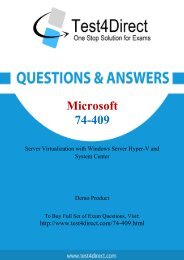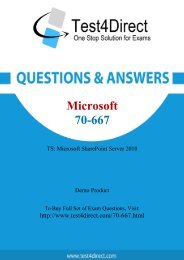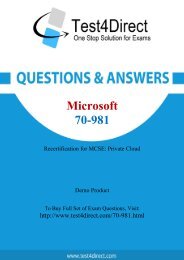70-646 Real BrainDumps
Test4Direct provides latest PDF questions of Microsoft 70-646 exam. You have an opportunity to pass the Microsoft 70-646 exam in one go. Test4Direct is most accurate source to prepare Microsoft 70-646 exam as your success will become site’s responsibility after purchasing 70-646 exam product. There are also lots of discounts and promotion offers that you can avail. Let’s try a free demo http://www.test4direct.com/70-646.html
Test4Direct provides latest PDF questions of Microsoft 70-646 exam. You have an opportunity to pass the Microsoft 70-646 exam in one go. Test4Direct is most accurate source to prepare Microsoft 70-646 exam as your success will become site’s responsibility after purchasing 70-646 exam product. There are also lots of discounts and promotion offers that you can avail. Let’s try a free demo http://www.test4direct.com/70-646.html
Create successful ePaper yourself
Turn your PDF publications into a flip-book with our unique Google optimized e-Paper software.
By default, the Net Logon service registers domain controller locator (Locator) DNS resource records<br />
for the application directory partitions that are hosted on a domain controller in the same manner as<br />
it registers domain controller locator (Locator) DNS resource records for the domain partition that is<br />
hosted on a domain controller.<br />
Primary zone<br />
When a zone that this DNS server hosts is a primary zone, the DNS server is the primary source for<br />
information about this zone, and it stores the master copy of zone data in a local file or in AD DS.<br />
When the zone is stored in a file, by default the primary zone file is named rone_name.dns and it is<br />
located in the %windir%\System32\Dns folder on the server.<br />
Secondary zone<br />
When a zone that this DNS server hosts is a secondary zone, this DNS server is a secondary source for<br />
information about this zone. The zone at this server must be obtained from another remote DNS<br />
server computer that also hosts the zone. This DNS server must have network access to the remote<br />
DNS server that supplies this server with updated information about the zone. Because a secondary<br />
zone is merely a copy of a primary zone that is hosted on another server, it cannot be stored in AD<br />
DS.<br />
Stub zone<br />
When a zone that this DNS server hosts is a stub zone, this DNS server is a source only for<br />
information about the authoritative name servers for this zone. The zone at this server must be<br />
obtained from another DNS server that hosts the zone. This DNS server must have network access to<br />
the remote DNS server to copy the authoritative name server information about the zone.<br />
You can use stub zones to:<br />
• Keep delegated zone information current. By updating a stub zone for one of its child zones<br />
regularly, the DNS server that hosts both the parent zone and the stub zone will maintain a current<br />
list of authoritative DNS servers for the child zone.<br />
• Improve name resolution. Stub zones enable a DNS server to perform recursion using the stub<br />
zone's list of name servers, without having to query the Internet or an internal root server for the<br />
DNS namespace.<br />
• Simplify DNS administration. By using stub zones throughout your DNS infrastructure, you can<br />
distribute a list of the authoritative DNS servers for a zone without using secondary zones. However,<br />
stub zones do not serve the same purpose as secondary zones, and they are not an alternative for<br />
enhancing redundancy and load sharing.<br />
There are two lists of DNS servers involved in the loading and maintenance of a stub zone:<br />
• The list of master servers from which the DNS server loads and updates a stub zone. A master<br />
server may be a primary or secondary DNS server for the zone. In both cases, it will have a complete<br />
list of the DNS servers for the zone.<br />
• The list of the authoritative DNS servers for a zone. This list is contained in the stub zone using<br />
name server (NS) resource records.<br />
When a DNS server loads a stub zone, such as widgets.tailspintoys.com, it quenes the master servers,<br />
which can be in different locations, for the necessary resource records of the authoritative servers for<br />
the zone widgets.tailspintoys.com. The list of master servers may contain a single server or multiple<br />
servers, and it can be changed anytime.<br />
Question: 12<br />
Your network is configured as shown in the following diagram.
















